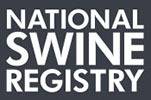 |
(l to r) Dr. Tom Baas, Ukrainian host,
Dr. Clint Schwab, Dr. Harold Hodson |
This is the third of a four-part series. Read Dr. Schwab’s description of the visit in Part I.
Part I, Dr. Clint Schwab visits Ukraine
Part II, Dr. Clint Schwab visits Ukraine
Dr. Clint Schwab, director of genetic and technical services for the National Swine Registry, visited Ukraine in July 2010 to both present information to swine producers in this country, as well as learn about their systems. Accompanying him were Dr. Tom Baas of Iowa State University, and Dr. Harold Hodson from Swine Genetics International, Iowa. Following are Schwab’s third set of photos and descriptions of this tour.
 |
| The third farm that we visited was Dnipro Hybrid Farm in Zhovti Vody City. It is owned by Getman Vladimir who coordinated our visit within Ukraine. As illustrated in the following pictures, many of the technological advances used throughout the U.S. and E.U. are incorporated at this unit. Here Baas and Hodson are having an in-depth discussion during the visit. |
 |
| The use of farrowing crates is not typical in Ukraine, but was used at this unit. The sow is a half-blood U.S. Yorkshire. Currently due to transport limitations that make it extremely complicated to get live animals to Ukraine, local breeders are aggressively pursuing the use of frozen semen to access U.S. genetics. |
 |
| Just prior to weaning at 21 days, these ¾ blood U.S. pigs will be used to transition this farm to genetics from the U.S. via frozen semen. Conception rates with frozen semen at this unit are greater than 80 percent. |
 |
| The nursery facility uses solid concrete floors heated with hot water. The perimeter of the pens has steel grated floors. The combination of this design with the “Airworks” ventilation design of Whiteshire Hamroc is functioning well. |
 |
| This unit very effectively uses a pen gestation system (above and below photos) with electronic sow feeders. Each female has an electronic tag, and her activity (feed intake, boar visits, etc.) is tracked in the computer. If she needs to be preg-checked, has an irregular eating pattern, has visited the boar a certain number of times, etc, she is automatically sorted into a “chore pen” during the night. This allows employees to take care of the most important items first thing in the morning and easily identify those sows that need immediate attention. These are things that are complicated to track and manage even in crate gestation units. |
 |
| An illustration of the boar station. Here each sow is able to get nose-to-nose contact with the boar and each visit she makes is recorded via the electronic tag. |
View photos and information from additional Ukraine swine farms in upcoming blog posts.
This entry was posted in
National Swine Registry. Bookmark the
permalink. Follow any comments here with the
RSS feed for this post.
Trackbacks are closed, but you can .









